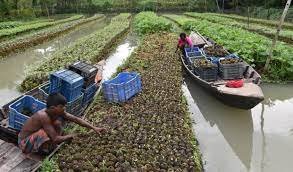Image Source
Bangladesh is a riverine country. We have more than 45 lakh hectares of water. Gopalganj, Barisal, Pirojpur, Satkhira, Chandpur, Comilla, Brahmanbaria, Netrokona, Kishoreganj, Sunamganj, Habiganj and many other districts are waterlogged during the monsoon season. It is submerged in water for about 6 months of the year. At this time there is no agricultural work, there is no harvest, people live an unemployed life. All those areas are covered with water hyacinth and other aquatic weeds at that time. Farmers in the south developed floating agricultural activities for their own needs. The submerged areas of these districts are covered with water hyacinth and other aquatic weeds, especially various beels, haors, drains, canals and fun ponds. There, they are now making various types of vegetables and spices year-round in a floating manner by making beds like rafts of the required size by stacking them in a scientific way. Floating vegetable and spice production technologies and fields, especially emergency aman paddy seedlings, have ushered in a new era in expanding production as an adaptation strategy for climate change in flood and waterlogged areas and opened new doors for agricultural prosperity. This activity is gradually expanding in waterlogged areas.
This year, under the direction of the high level of the Ministry of Agriculture, aman paddy seeds were planted in floating beds in these flood-affected areas. So far, at least 600 floating beds have been planted with aman seeds. Aman seedlings of 20 to 25 days old can be planted in the main land immediately after the water recedes from the submerged land or after the submerged land wakes up. It does not waste time, aman can be planted by adjusting with time. Aman yield is not disturbed. Even in places where aman seedbed cannot be sown due to rains and floods, aman can be planted in these lands in time with the help of aman paddy seedlings produced in floating beds without wasting time if rain or flood water is drawn. It saves time, has many benefits. This technology has already gained a lot of popularity. This is benefiting agriculture and farmers in many ways.
The main ingredient in making floating beds is water hyacinth. Apart from this, floating beds can be made using topapana, algae, various types of aquatic weeds, dulalilata, paddy straw or crop residues, sugarcane husk, sodust. The durability of the bed is enhanced by making a bed with large and long water hyacinths of mature dark green color. Where dulalilata is not found, ball meda is made with jute rope instead of dulalilata. In addition, coconut husk powder is used for making saplings. In case of floating seedbed, the seed rate will be 80 to 100 grams per square meter like other normal seedbed. In this case 35 big square meters or about 1 hundred floating seedlings can be used for planting one bigha of land. If the seedlings are 20 to 25 days old, they can be picked up and planted in the field. This eliminates the need to use the original land for rice seedling production. Land use is affordable. It is possible to make more profit by producing the desired crop quickly in the vacant land. Seedlings made in this way should be planted like other normal seedlings and care and management should be the same as other normal seedling seedlings. The seedlings produced yield the same as all other normal seedlings. The seedbed does not usually need irrigation to stay afloat in the water, but can be sprinkled with water from time to time.
Usually there is no place to plant seeds in flood prone areas during monsoons. Moreover, after the flood waters recede, there is no time to make seedlings. Seedlings can be produced by sowing germinated aman seeds in case of emergency in a bed made of water hyacinth and aquatic weeds. However, before sowing the seeds, it is necessary to make a wet seedbed with a layer of 2-3 cm of pond soil or a thin layer of soil on the bed. The floating seedbed bed should be tied to the poles with a rope so that the floating bed does not float in the flood water. Care should be taken after spraying so that birds or some other seeds do not spoil.
Floating beds contain a lot of essential nutrients of plants so seeds can be sown or planted more densely than in flat lands. Due to the high organic manure in the floating bed, the crop grows faster than the conventional cultivation in the land and in many cases yields are about 3-5 times higher. When the water level drops at the end of the flood, when these floating beds sit on the ground, they can be broken down and spread on the ground or mixed with the soil to produce different crops successfully. In addition, at the end of the season, rotten water hyacinth can be used as a fertilizer at the base of the fruit tree to increase fruit production. Yield can be increased by using rotten water hyacinth at the base of the fruit tree. In our country, the required amount of organic manure is not being given to the cultivable land. In this situation, if vegetables and spices are produced using water hyacinth in low lying areas of the country, it will provide nutrition through safe production of vegetables and spices as well as use of rotten water hyacinth as organic manure in the land. Will contribute dimensionally. Land use can be made affordable. There are opportunities to use fallow land. By following this method, the farmer brothers will be able to make more profit by compensating the losses and getting the desired yield. This activity will save time on floating beds, crop lands can be utilized in advance, costs will be saved, profits will be higher and environmentally friendly agricultural production will be further expanded.
